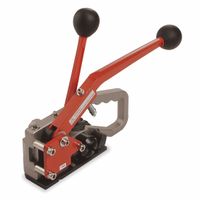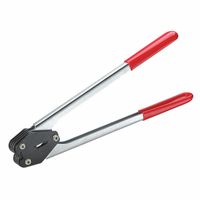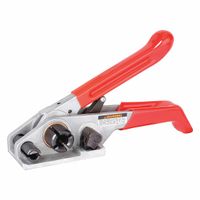Call +(254) 703 030 000 / 751 483 999 / 721 704 777
- Home
- Packaging Shipping
- Strapping
- Strapping Tools
- Tools For Polyester Strapping
.....Read More
Frequently Asked Questions
What are the best tools for polyester strapping tensioning, cutting, and sealing?
The best tools for polyester strapping tensioning, cutting, and sealing are typically categorized into manual, pneumatic, and battery-powered options, each suited for different operational needs and volumes.
1. **Manual Tools**:
- **Tensioners**: Manual tensioners are ideal for low-volume applications. They are cost-effective and easy to use. The windlass tensioner is a popular choice for its ability to apply high tension.
- **Cutters**: Manual cutters are designed to cleanly cut polyester strapping. They are often used in conjunction with manual tensioners and sealers.
- **Sealers**: Manual sealers use metal seals to secure the strapping. They are reliable for small-scale operations.
2. **Pneumatic Tools**:
- **Combination Tools**: Pneumatic combination tools perform tensioning, sealing, and cutting in one device, increasing efficiency. They are suitable for medium to high-volume applications.
- **Tensioners and Sealers**: Pneumatic tensioners and sealers offer consistent tension and seal quality, reducing operator fatigue.
3. **Battery-Powered Tools**:
- **Combination Tools**: Battery-powered combination tools are highly portable and efficient, making them ideal for high-volume operations. They offer adjustable tension and sealing settings for different strapping needs.
- **Tensioners and Sealers**: These tools provide the flexibility of cordless operation with the power to handle heavy-duty strapping tasks.
4. **Automatic Strapping Machines**:
- For very high-volume operations, automatic strapping machines offer the fastest and most efficient solution. They automate the entire process of tensioning, sealing, and cutting, significantly reducing labor costs and increasing throughput.
Choosing the right tool depends on the specific requirements of the operation, including volume, budget, and the need for mobility and automation.
How do I choose the right tensioner for polyester strapping?
To choose the right tensioner for polyester strapping, consider the following factors:
1. **Strap Width and Thickness**: Ensure the tensioner is compatible with the specific width and thickness of the polyester strapping you are using. Check the manufacturer's specifications for compatibility.
2. **Type of Load**: Determine the nature of the load being secured. For heavy-duty applications, a more robust tensioner is required, while lighter loads may only need a basic model.
3. **Tensioning Force**: Evaluate the required tensioning force. Different tensioners offer varying levels of tension. Choose one that can apply the necessary force without damaging the strapping or the load.
4. **Manual vs. Powered**: Decide between manual, pneumatic, or battery-powered tensioners. Manual tensioners are cost-effective and suitable for low-volume operations. Pneumatic and battery-powered tensioners are ideal for high-volume or high-tension applications, offering speed and efficiency.
5. **Ease of Use**: Consider the ergonomics and ease of operation. A user-friendly tensioner reduces operator fatigue and increases productivity.
6. **Durability and Maintenance**: Look for tensioners made from durable materials that can withstand regular use. Consider the maintenance requirements and availability of spare parts.
7. **Budget**: Balance your needs with your budget. While higher-end models offer advanced features, ensure they align with your operational requirements.
8. **Brand and Support**: Choose reputable brands known for quality and reliability. Consider the availability of customer support and warranty options.
9. **Safety Features**: Ensure the tensioner has safety features to protect the operator and prevent accidents.
By evaluating these factors, you can select a tensioner that meets your specific needs for polyester strapping applications.
What is the difference between manual and battery-powered strapping tools?
Manual strapping tools require human effort to tension, seal, and cut the strapping material. They are typically lightweight, portable, and cost-effective, making them suitable for low-volume or occasional strapping needs. These tools are ideal for smaller operations or where electricity is not readily available. However, they can be labor-intensive and time-consuming, as the operator must manually perform each step of the strapping process.
Battery-powered strapping tools, on the other hand, automate the tensioning and sealing process, significantly reducing the physical effort required by the operator. These tools are equipped with rechargeable batteries, allowing for mobility and ease of use in various locations. They are faster and more efficient than manual tools, making them suitable for high-volume operations. Battery-powered tools provide consistent tension and seal quality, reducing the risk of human error. However, they are generally more expensive than manual tools and require regular battery maintenance and charging.
In summary, the main differences lie in the level of automation, efficiency, and cost. Manual tools are more affordable and suitable for low-volume tasks, while battery-powered tools offer speed and consistency for high-volume operations but come at a higher cost.
How do I properly use a combination tool for polyester strapping?
1. **Preparation**: Ensure you have the correct size and type of polyester strapping for your application. Cut the strapping to the required length, allowing extra for overlap.
2. **Positioning**: Place the strapping around the package or pallet. Overlap the ends of the strapping by a few inches.
3. **Loading the Tool**: Insert the bottom strap into the tool's base. Pull the top strap over the base and insert it into the tensioner section of the tool.
4. **Tensioning**: Use the tensioning lever to tighten the strapping around the package. Ensure the strapping is snug but not overly tight to avoid damaging the package or the strapping.
5. **Sealing**: Once the desired tension is achieved, place a seal over the overlapping straps. Use the sealing lever to crimp the seal, securing the strapping in place.
6. **Cutting**: After sealing, use the cutting lever to trim the excess strapping. Ensure the cut is clean to prevent fraying.
7. **Inspection**: Check the tension and seal to ensure the strapping is secure. Adjust if necessary.
8. **Safety**: Always wear appropriate safety gear, such as gloves and eye protection, when using the tool.
9. **Maintenance**: Regularly clean and inspect the tool for wear and tear. Lubricate moving parts as needed to ensure smooth operation.
10. **Storage**: Store the tool in a dry, safe place to prevent damage and ensure longevity.
What are the maintenance tips for strapping tools?
1. **Regular Cleaning**: After each use, clean the tool to remove dust, debris, and any residue from the strapping material. Use a soft brush or compressed air for hard-to-reach areas.
2. **Lubrication**: Apply appropriate lubricants to moving parts as recommended by the manufacturer. This reduces friction and wear, ensuring smooth operation.
3. **Inspection**: Regularly inspect the tool for signs of wear or damage. Check for loose screws, worn-out parts, or any misalignment that could affect performance.
4. **Blade Maintenance**: Keep cutting blades sharp and free from nicks. Replace blades that are dull or damaged to ensure clean cuts and prevent strain on the tool.
5. **Battery Care**: For battery-operated tools, ensure batteries are charged and stored properly. Avoid overcharging and keep spare batteries on hand.
6. **Calibration**: Periodically check and calibrate the tool to ensure it applies the correct tension. This is crucial for maintaining the integrity of the strapping.
7. **Storage**: Store the tool in a dry, clean environment to prevent rust and corrosion. Use protective cases or covers if available.
8. **Training**: Ensure that all operators are properly trained in the use and maintenance of the tool to prevent misuse and extend its lifespan.
9. **Manufacturer Guidelines**: Follow the manufacturer’s maintenance schedule and guidelines for specific care instructions and part replacements.
10. **Professional Servicing**: Schedule regular professional servicing to address any complex issues and ensure the tool remains in optimal condition.
How do I determine the correct seal type for polyester strapping?
To determine the correct seal type for polyester strapping, consider the following factors:
1. **Strap Size and Thickness**: Ensure the seal matches the width and thickness of the polyester strapping. Common sizes include 1/2", 5/8", and 3/4".
2. **Tensioning Requirements**: Assess the tensioning force needed for your application. Polyester strapping can handle high tension, so choose a seal that can withstand the required force without slipping.
3. **Seal Strength**: Evaluate the seal's breaking strength. Polyester strapping is strong, so the seal must be equally robust to maintain the integrity of the strapping.
4. **Seal Type**: Choose between open, closed, or serrated seals. Open seals are easier to apply but may not be as strong as closed seals, which provide a more secure hold. Serrated seals offer extra grip and are ideal for high-tension applications.
5. **Application Method**: Decide between manual, pneumatic, or battery-operated tools. The seal type should be compatible with the tool used for application. Manual tools may require different seals compared to pneumatic or battery-operated tools.
6. **Environmental Conditions**: Consider the environment where the strapping will be used. If exposure to moisture or chemicals is a concern, select seals that resist corrosion and degradation.
7. **Cost and Availability**: Balance the cost of seals with their availability and performance. High-quality seals may be more expensive but offer better performance and reliability.
8. **Testing and Validation**: Conduct tests to ensure the chosen seal type meets your specific requirements. This includes testing for tension retention, seal integrity, and overall performance under expected conditions.
By considering these factors, you can select the appropriate seal type for your polyester strapping needs.
Can polyester strapping tools be used for other types of strapping materials?
Polyester strapping tools are primarily designed for use with polyester strapping, but they can sometimes be used with other types of strapping materials, depending on the tool's specifications and design. These tools are generally compatible with polypropylene strapping, as both materials have similar properties and require similar tensioning and sealing methods. However, the effectiveness and safety of using polyester tools with polypropylene strapping can vary, so it's important to consult the manufacturer's guidelines.
For steel strapping, polyester strapping tools are typically not suitable. Steel strapping requires different tensioning and sealing techniques due to its higher strength and rigidity. Tools designed for steel strapping are built to handle the material's specific characteristics, such as its need for higher tension and different sealing methods, like crimping or welding.
When considering using polyester strapping tools for other materials, it's crucial to ensure that the tool can apply the necessary tension and create a secure seal. Using the wrong tool can lead to inadequate tension, improper sealing, and potential safety hazards. Always refer to the tool's manual and manufacturer recommendations to determine compatibility with different strapping materials.
In summary, while polyester strapping tools may be used with polypropylene strapping, they are generally not suitable for steel strapping. Always verify compatibility and follow manufacturer guidelines to ensure safe and effective strapping operations.


